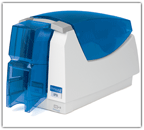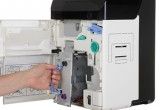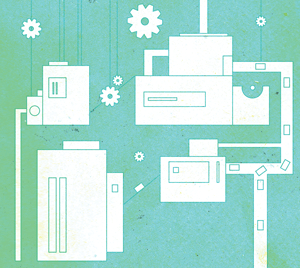Companies roll out low cost ID card printers with higher end functionality
Leading manufacturers offer new models to address changing needs of campus and corporate card issuers
04 January, 2008
category: Contactless, Corporate, Digital ID, Library
By Andy Williams, Contributing Editor
A few years ago, demand among smaller organizations was limited for low cost ID card printers that could print quality images on IDs with embedded technologies (e.g. smart cards, contactless cards, prox cards). But a lot has changed in just a few years with new regulations and growing demands for ever-greater security. Now, printer manufacturers are trying to keep pace, offering lower end models that can produce high quality images on embedded technology cards at a lesser price.
Major printer manufacturers including Datacard, Digital ID, Evolis, Fargo, and Magicard are all addressing this new sector with high function, high value models.
Fargo offers lower cost retransfer model to make secure cards affordable
Although by no means alone in this endeavor, Fargo Electronics, which specializes in secure identification technologies, including printers that can churn out smart IDs, recently released a lower cost printer designed for small- to mid-tier environments.
Calling it “high tech for the masses,” Fargo’s HDP 5000 is inexpensive–at least by High Definition Printing standards, according to the company’s vice president of product marketing, Steve Blake.
“We decided to do it because customers really like the print quality and they’ve clamored for it over the years, but the pricing was high compared to the traditional (dye sublimation) printing,” he said. “With smart card growth, people are asking us more and more for High Definition Printing technology, but at an affordable price.”
Fargo also hopes its lower price will enable it to gain a greater market share in the growing U.S. market for ID cards with embedded technologies. “Smart card technology hasn’t had as high a level of adoption in the U.S. as in Europe, but it’s definitely growing,” he said.
The HDP-5000 uses reverse imaging technology, ideal for printing on a card with a chip because the printhead never comes in contact with the card. “We’ve offered this for a few years in other products and platforms, but our latest generation is more affordable. It used to be suitable for (high end projects, like) government ID programs or for other high security applications. It used to be premium priced, but with the HDP5000, we’ve established new ground with a printer that fits the corporate market, or ski resorts or colleges and universities,” he added.
How inexpensive is it? The HDP 5000 starts at $3,995, about half the price of the traditional high-end models. “Our component sourcing and customer-focused design have resulted in a lower cost of manufacturing so it’s more affordable,” he said.
This printer can also grow as the company grows. “A lot of mid-level customers want to start small and grow later but they don’t have the budget for all the bells and whistles that a high end printer offers. While many card printers aren’t upgradeable, the HDP-5000 was designed to be modular. Today, they may be doing single sided printing, not mag stripe or contact and contactless or lamination. But they’re thinking about it down the road. They can get the platform, a single-sided base printer, and then a year from now can add a flipper module for dual sided cards. It flips the card over and brings it back to print the back side of the card. You can also add the ability to encode contact/contactless, mag stripe or prox cards.”
Other printer manufacturers have realized the need to serve the smaller company or college and also have developed inexpensive printer offerings. Evolis, Digital Identification Solutions and Magicard all have low-cost printers.
Evolis offers a flexible array of printers for low and high end needs
Gerardo Talavera, Evolis managing director, said there has been “a lot of demand” for low-end printers. He estimates that 85% of total sales comes in this area. Evolis has printers starting around $1,600.
He said most of the cards being produced with Evolis printers are for ID, access control, or for a loyalty program–cards that don’t necessarily have to be really secure The high end, the other 15%, includes the high security printers “that come with lamination and other features,” he added.
The company’s best-selling printer has been the Pebble, “a basic single-sided color printer, one of the most successful in the industry,” he said.
But, he added, “there’s really not much security on the low end.” The Pebble lists for around $2,000. “The first generation came out seven years ago (when the company was first started) and we’ve been developing different generations since then,” he said.
While Evolis’ lower end printers have encoding capabilities for “RFID (contactless), contact, mag stripe without them having to buy several printers,” the company also offers “low cost generic overlay holographic images that will give you some security because it’s adding more to the card.”
“…Instead of spending the money on holograms, (many organizations choose to) preprint the cards with another company which allows them to add different security features. They then just use the printer to personalize the card,” said Mr. Talavera.
Digital ID reminds clients to choose based on total cost of ownership, rather than initial price
Shane Cunningham, inside sales and marketing manager, Digital Identification Solutions, believes that some inexpensive printers may cost more in the long run. “A system with a large price tag can actually be very cost effective without being considered cheap,” he said. “Reliability, flexibility, and scalability can play a major role as to whether a system is worth the expense or not. Just because a printer may cost (little) initially, it doesn’t mean that it won’t cost you more in repairs, man-hours and headaches in the near future. It all comes down to real value, which can only be determined by the user, not the price tag.”
“When we opened our doors (in 2003), we started with retransfer printers, but added the value line in 2005.”
Digital ID’s value line, direct to card printers starts with introductory level hand-fed printers that do one card at a time, he said.
“There is a certain perception as to what’s affordable. Even our higher end printer, with all the options for anything you want to do, ends up being cheaper than a regular direct to card printer,” he added. He maintains that a high-end printer going to film rather than directly to a card can outlast the printhead on direct-to-card printers by a factor of 15. In other words, “you’ll replace 15 direct card printers in that time. However if someone is only printing 500 cards a year, that’s probably overkill.”
The DCP 360i, a direct to card printer with all the features (e.g. options for chips, contactless, dual sided printing) lists for about $4,200. “The 360 is the lowest end of our professional line,” he added. But the company also offers its value line starting with the DCP 100 ($1,500), explains Mr. Cunningham. “It offers a single sided hand-fed direct to card printer.” Higher up is the 340 ($3,900) “which prints double sided and is designed to be inexpensive.”
“If all you need is an ID card, the value line is for you; if you need a secure credential, then the professional is for you,” he added.
He agrees with Evolis’ Mr. Talavera that “if you want some truly secure cards for your organization, but you need less than 500, you can get around that by going to a service bureau. They can produce the cards for you without you buying the hardware.”
Sometimes, however, perception is everything. In at least one instance, recalls Mr. Cunningham, price wasn’t as much an issue as how the card looked–specifically the picture on the card. “A small cosmetics college in Nevada purchased our 570i retransfer printer (a high end product that retails for about $7,800). The reason they bought it is that students liked their pictures produced by the retransfer printer. The students were willing to pay for a more expensive ID card.”
Magicard offers a full range including low cost ID card printers … from Opera to Tango to Rio
Andy Matko, marketing manager for UK-based Magicard, said that a number of years ago, ID badges were for the larger companies. If a small company wanted badges for its employees, it sought out a service bureau. “Now everyone is buying printers rather than badges from a service bureau. We’re all impatient. You have a new employee, you want to badge them that day. But it’s not just companies, but things like sports clubs.” This is one of the markets Magicard is reaching with its low cost–some under $1,000–printers.
Magicard’s low-end printer, Opera, retails for less than $1,000. “It’s a small hand-fed printer that can produce ID cards,” said Mr. Matko. “We’re finding a lot of small companies or small organizations of 50 or 100 people will buy this type of printer. Opera is good for the Internet market and it comes with badging software.”
He added: “We saw there were a lot of people that weren’t able to get into badging, essentially due to price. They needed a simple printer, an entry-level package, which opened up the markets for us.”
These lower-end direct to card printers “are not designed for high volume.” They will print on smart cards, but not encode them,” explains Mr. Matko. “So there isn’t a lot of security there.”
If you want security, Magicard’s Rio–about $3,000–will produce a customizable visual security-type watermark that the company calls Holokote. “It puts a watermark on the card which means your card can’t be copied,” said Mr. Matko.
In the $4,000 arena is Magicard’s Tango. “It offers a range of encoders that are built into the printer,” said Mr. Matko. “Tango can print hundreds of cards a day, you can network them and include visual security on the cards.”
He added: “We saw the need for low cost printers from end users. People were saying they couldn’t afford a printer, too much money. It’s a rapidly evolving industry. While we started in 1993, it wasn’t until the late 90s that these printers became common, and even then you couldn’t buy them for anything less than $7,000.”
“Companies are badging people for the first time and they’re looking for value and simplicity. That’s what we’re trying to tap into.”




